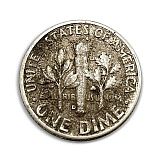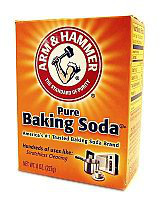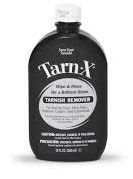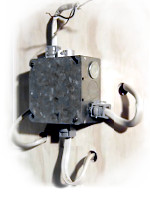Owners Guide
Now that you've acquired some junk silver, how should you care for it?
Cleaning Junk Silver

Note - I do not recommend cleaning any coin that has collectible value, including silver dollars. The tarnish on these collectible coins is actually "patina" or "toning". Cleaning these coins can significantly reduce their value.
People have different feelings about cleaning junk silver coins. Some people insist that junk silver should never be cleaned. Some people polish their junk to a mirror finish. Here's my view... The value of a junk silver coin is determined by the following equation: Value = (Spot Price * Silver Content) + Markup. It's a very simple equation, and an astute observer will notice that "condition" is not a factor. Therefore, altering the condition by cleaning must not be detrimental to value. If cleaning a coin is going to affect it's value, then it must not be a junk silver coin. Having said that, I become suspicious when I see a 50 year old coin without a hint of tarnish. Furthermore, I think a small to moderate amount of tarnish on junk silver drastically improves it's aesthetics when compared to coins that lack any tarnish or have become heavily tarnished.
I urge you to do some research, ask some questions and decide which category you fit into. To be safe, you may not want to clean any junk silver until you're familiar with the coins and their potential numismatic value.

If you decide to clean your junk silver, there's several methods to choose from...
Simply washing junk silver with soapy water can remove most of the dirt and grease residue without affecting the patina or toning. This is a good way to clean junk silver if you're concerned about affecting it's value. Avoid putting full strength soap directly on your junk silver. Some soaps have phosphates that can tarnish the silver. Latex gloves can contain sulfur that can tarnish silver.
Baking soda is a very soft abrasive and can be used without damaging your coins. Do not use anything abrasive, including polishing compounds, polishing cloths, etc. I like to make a paste with baking soda and a little soapy water, then gently rub the coins and paste between my fingers and thumb. This process will remove most of the tarnish. Stubborn dirt and tarnish can usually be removed by gently scrubbing with baking soda and a toothbrush.
The "baking soda and aluminum foil" method is a popular way to clean junk silver. Fill a plastic or other non-metallic container with enough hot water to cover the coins. Mix in baking soda until no more will dissolve. Place a piece of aluminum foil in the bottom of the container. Place the coins on the foil in a single layer and wait a few minutes for the tarnish to be cleaned. The dark colored tarnish on silver is silver sulfide. It forms when silver is exposed to sulfur. Aluminum also reacts with sulfur. Fortunately, aluminum is more prone to react with sulfur than silver. By placing silver in contact with aluminum, the sulfur migrates from the silver sulfide to the aluminum to form aluminum sulfide. As the sulfur leaves the silver sulfide, it's converted back to silver. The baking soda in the water helps the reaction to occur.

You can also use a liquid jewelry cleaner, although that will likely remove all the patina and toning. These cleaners are generally inexpensive and work fairly well. Some are intended to be used in an ultrasonic cleaning machine, others are supposed to be used with a brush or a cloth. Rinse your coins thoroughly after using these chemical cleaners.
You might try tumbling or vibrating junk silver in a soft media like corn cob grit or ground walnut shells.
A quick dip in acetone can remove all oil and grease residue. I avoid using acetone because it's very harsh. Only use it in a well ventilated area and avoid contact with your skin.
Storing Junk Silver
There's several things to consider when deciding how to store your silver. You should evaluate accessibility, security, environmental conditions, cost, etc. Ideally, your silver should be easily accessible so you can get to it quickly in an emergency, but not so accessible that a thief can easily steal it. You'll also want to keep younger kids from finding it. They probably won't realise a few junk silver quarters are worth quite a bit more than regular quarters as they spend your junk silver coins on a painfully expensive candy bar.
Storage location and containers can tarnish your junk silver. Your junk silver is already tarnished from age and it generally doesn't affect it's value, so it probably won't be a major concern for most people. Tarnishing is a natural process and some people even like some tarnish (or "toning") on their silver. If you're worried about it you can take some precautions to help reduce tarnishing. First, silver tarnish is (mostly) silver sulfide. It forms when silver is exposed to sulfur. Sulfur is very common and it's found in many, many things - even air. The best way to reduce tarnishing is to prevent sulfur from contacting your silver. This can be accomplished by sealing your coins in an airtight container that does not contain sulfur, for example high quality coin tubes, polyethylene plastic bags (e.g. FoodSaver bags) or mylar bags. You should also consider adding silica gel to absorb moisture and anti-tarnishing strips that scavenge sulfur from the air. The storage location should be cool and dry. You can also store your silver in a flannel cloth that's been treated with silver nitrate or other chemicals (sometimes called silvercloth) to reduce tarnishing. Avoid storing your silver in or around unfinished wood, plastic cling wrap, newspaper, tissue paper, cardboard, wool, felt or rubber bands. They can contain sulfur and other substances that will tarnish your silver.
You probably won't find one method that excels at everything so some compromises will need to be made. I recommend storing your silver in multiple places. As the saying goes, "Don't put all your eggs in one basket." I'll list a few options:
Nightstand / Dresser Drawer
Probably the cheapest and easiest method, especially for small amounts of silver. Accessibility and environmental conditions are generally good, but there's no security.
Hidden Around The House

Cheap, better security than a drawer (depending on how well you hide it), probably good environmental conditions (depending on where you hide it), accessibility is probably fairly good, but hiding may be impractical for large amounts of silver. Is that electrical junction box filled with silver or deadly high voltage electrical wires? You can get a metal junction box with a cover at any hardware store for a couple dollars. They come in several sizes. The standard depth is too shallow to hold Silver Eagles and silver dollars, so try to get the deeper boxes. A short length of electrical wire running out of the box is a nice addition. Don't use an existing electrical junction box with live wires in it. Silver is a very conductive metal. PVC pipe may cause some tarnishing, but it's cheap, easy to cut, commonly found in homes and easy to find at any hardware store. If the silver isn't exposed to the PVC, it can make a great hiding place. Note that PVC pipe diameter is specified by inside diameter. A piece of 2 inch diameter PVC pipe will hold a stack of Silver Eagles, but the square-ish plastic Silver Eagle tubes from the mint (with the green tops) will not fit. You can find round plastic tube holders that will hold 20 Silver Eagles and fit very nicely in 2 inch diameter PVC pipe. Attach an end cap, add some dirty stains, and place it in a suitable location. Electrical boxes and PVC pipes are only a couple ideas, the possibilities are only limited by your imagination.
Bank Safe Deposit Box
Good environmental conditions and outstanding security from theft, but gold and silver have been confiscated by the government (Executive Order 6102 in 1933). Accessibility may not be as good as you think. Banks will almost certainly be closed if there's an emergency. If there's a banking crisis the banks are usually closed without any warning. You may have to deal with an unruly crowd outside the bank in the event of civil unrest. Costs may be an issue. One of the benefits of holding silver is the lack of reoccurring expenses (taxes, fees, etc) that other assesses require. A deposit box extirpates that benefit.
Burying In The Yard
Accessibility can be dirty and difficult, especially if you can't quite remember exactly where you buried your treasure chest. I strongly recommend marking the spot with a bird bath or some other marker. Be careful not to cut a water pipe, phone line or other buried utility. Avoid burying close to a tree where the roots can grow around your silver and make it difficult to dig out. Also, trees will occasionally fall over in a storm, which can expose your silver. Security can be fairly good but since there's no real physical barriers to theft, it's imperative that it be kept secret. This method is susceptible to metal detectors, so I recommend that you not bury anything on public land. Environmental conditions can be very good if your container is water-proof and completely sealed. PVC pipe would make a good container but it can tarnish silver so you may want to protect your silver from PVC exposure. Costs are low, unless you forget your burial spot and have to rent a backhoe to dig up your yard.
Home Safe

In my humble (and non-expert) opinion, safes are overrated and usually provide a false sense of security. If a safe can be moved, a thief will move it. They'll either carry it, use a dolly or winch it onto a truck. Either way your safe and it's contents are gone. They can be difficult to bolt down. If it's not movable, it can be opened - it's just a matter of time. Give a motivated, experienced thief some time with a saw, sledge hammer, crow bar, maybe a torch and some power tools and he can probably get in. It usually requires a lot of money to buy a safe that's actually going to keep someone out and have it properly installed so it can't be moved. Even the most secure, impenetrable safe will not keep someone out if they have a gun to your head. A good safe is going to be extremely heavy and very difficult to move into your house. Whatever you do, do not put your silver in a cheap, small safe (usually intended for documents). They're the first thing a thief will take, and they're often easily opened with a hammer and screwdriver. In summation, if you have a good safe that's properly installed, use it, otherwise I'd urge you to consider other storage options.